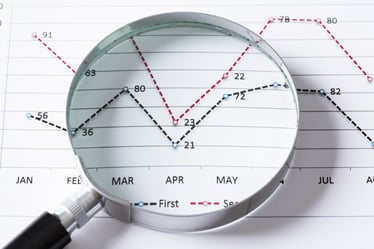Meet the New ZOLL Dispatch and ZOLL Respond CAD Solution
A beginner’s guide to using EMS data to measure performance
ZOLL SUMMIT Speaker Series Let’s put it right out there…data is everywhere! Business and professionals across the globe have gone data crazy, including EMS

ZOLL SUMMIT Speaker Series
Let’s put it right out there…data is everywhere! Business and professionals across the globe have gone data crazy, including EMS. If it seems like there has been a drastic increase in capturing and utilizing data over the past few years, you are correct. Data is all around us. Look at any of the recent journals or blogs that are dedicated to EMS, and chances are you will come across not just one, butnumerous articles discussing the use of data. Collecting, analyzing and actioning data is not an entirely new concept. Leveraging data to improve performance has been around for centuries. One report I came across stated that data was used in early Mesopotamia to record the growth of crops and herds. Fortunately, our ability to collect, sort, interpret and use recorded data has improved significantly in the 7,000 years since.
Although I rather doubt that early Mesopotamia had to deal with ePCR closed call rules…
Data geeks unite!
Over the past two decades, the interrelation between EMS services and the I.S. programs that support them has been solidified. It is rare today to find an agency where a strong I.S support structure is not in place. Computer Assist Dispatch (CAD), Electronic Patient Care reporting (ePCR), Automatic Vehicle Location (AVL) systems, and Revenue Management systems are relatively standard in most agencies. The interoperability of these systems and their capacity to connect with other systems outside the agency enhance the ability to help EMS services excel. For die hard data geeks, the amount of data that today’s EMS agencies produce and collect is the equivalent of a mouse in a cheese factory.
Heads or tails, which way do I go?
Where does one begin?
What metrics do you look at?
What do you compare it to?
How do you manage the large volumes of data at your fingertips in a way that’s beneficial to your business and your bottom line?
How do you translate the data you are seeing into actionable items that are geared towards improvement?
Even for those who are well experienced at looking at data and understanding what it is saying, it’s easy to get so far into the weeds that it quickly becomes overwhelming. Whether you’re a seasoned data analyst or just beginning to look at your service’s data, here are a few basic concepts to keep in mind as you start to understand and utilize data, and then how to turn those insights in action – putting them to work making improvements your system.
Step 1: Identify 
When looking at what measures to track, keep a few things in mind.
- What is it you want to measure, and how does it impact your business’s performance?
- Will that performance metric tell you what you’re trying to find out about your agency’s performance?
Some performance indicators give you enough information on their own, whereas others only give you part of the story and should be combined with additional metrics for a more well-rounded, in-depth analysis of performance.
Step 2: Define
Once you have identified performance measures that you want to look at, the next step is to define what goes into that metric.
- At what point will the measure start?
- When will the measure end?
- Will every call be included?
- Which ones will be excluded?
- How often will it be measured?
As is often heard, if you’ve seen one EMS service, you’ve seen one EMS service. Businesses may have similarities amongst them, but every one also has a uniqueness about them. How one service measures performance may not be work for your service. Understanding those differences, and how it relates to measuring performance and establishing consistency, is key to accurately measuring performance.
Step 3: Use
Just as important as identifying and defining performance measures, it is equally crucial that an agency determines what they are going to do with the information they have collected. Here are a few starting points:
- Review and report on the data regularly for trends
- Develop performance improvement projects
- Share the data with key stakeholders and staff
 These are just a few examples of how data can be used to improve performance. Sometimes simply knowing that something is being looked at on a regular basis is enough to drive a change in performance. Other times a structured performance improvement project needs to be developed and implemented to affect the changes needed. Regardless, measuring and improving performance requires that data be collected and used appropriately.
These are just a few examples of how data can be used to improve performance. Sometimes simply knowing that something is being looked at on a regular basis is enough to drive a change in performance. Other times a structured performance improvement project needs to be developed and implemented to affect the changes needed. Regardless, measuring and improving performance requires that data be collected and used appropriately.
No matter the size of your business, most EMS agencies today capture some type of data that can be used to understand and improve performance. Chances are, your service has more data available than you could ever possibly use. The great thing about today’s high-tech EMS systems is that if there’s a performance measure you want to look at, there is a high likelihood that the data you want and need is already being captured. The challenge then becomes identifying the metrics and extracting it in a way that's useful. EMS agencies tend to get into trouble when they do not have a structured process in place to identify, define and use data – or when they try to measure more indicators than they can efficiently manage.
Whether it is only a couple of elements or several dozen that are integrated with analytic software, make sure you are only measuring the amount of data your agency can comfortably and efficiently manage. The key isn’t just to collect it, it’s to use it!
Want to know more? Register for SUMMIT and make sure to attend Sean Kukauskas’s session on Why Performance Matters: The Real Cost of Performance.
Related Posts
Collect More Revenue Faster: The Pivotal Role of Clear, Concise, and Complete Documentation
ZOLL Pulse Blog
Subscribe to our blog and receive quality content that makes your job as an EMS & fire, hospital, or AR professional easier.
ZOLL Pulse Blog
Subscribe to our blog and receive quality content that makes your job as an EMS, fire, hospital, or AR professional easier.






